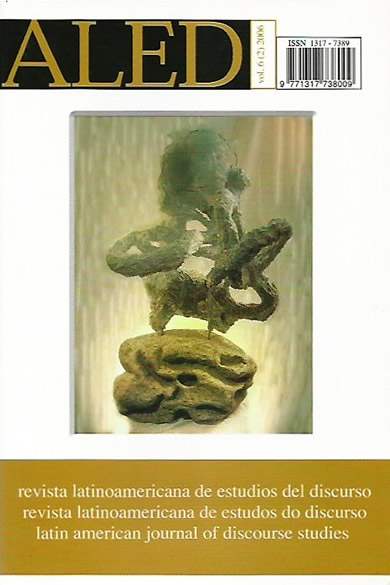Tango
el lenguaje quebrado del desarraigo
Keywords:
Tango. critical discourse analysis. belief system. socio-historic situation.Abstract
In this paper, from the theoretical framework of Critical Discourse Analysis and through a qualitative methodology (Fairclough and Wodak, 1997), I examine linguistically the period of emergence and maturity of tango. The operations of allocation of meaning related to the love theme and sentimental bias are explored as substantial elements of the tango genre. The aim is to see how these elements reveal aspects of the belief systems of the subjects and the social practices during the last period of the nineteenth century and the first decade of the twentieth. The linguistic analysis shows that the sentimental bias is built on the basis of the dichotomous representation of the sign woman in connection with a temporary triadic structure. Finally, the analysis focuses on the historical and social situation of the time because it was this situation that generated the need to channel and represent this hermetism in terms of symbols.
Downloads
References
ADELSTEIN, A. (1996) Enunciación y crónica periodística. Buenos Aires: Ars.
BAJTÃN, M. (1979) Estética de la creación verbal. México: Siglo XXI.DI
TELLA, T.S. (1988) Sociología de los procesos políticos. Buenos Aires: Eudeba.
FAIRCLOUGH, N. &WODAK, R. (1997) ‘Critical Discourse Analysis’, en T.A.van Dijk (ed.), Discourse as social interaction, vol. 2, pp. 258-284. London:Sage.
HIMSCHOOT, O. B. (2000) El tango: la pasión del 2 x 4. Buenos Aires: EditorialPolicial.
LAVANDERA, B. (1985) ‘Decir y aludir: una propuesta metodológica’, Filología19 (2): 21-31.
LERNER, I. (2001) La clase es un tango, Barcelona: Facultad de Filología.
MOFFAT, A. (1984) Psicoterapia del oprimido. Buenos Aires: Alternativas.OLIVERI, M. (2006) Antología de tangos lunfardos. Buenos Aires: EdicionesLibertador.
PARDO, M. L. (2003) La representación discursiva de la identidad nacional durantela década del 20: inmigración y nacionalismo en la Argentina’. En Ortiz, T.Pardo, M. L. y Noblia, V. (Coords) Origen y transformación del Estado argentinoen períodos de globalización, (pp. 73-94). Buenos Aires: Biblos.
PAZ, O. (1959) El laberinto de la soledad. México: Fondo de Cultura Económica.PENAS, A.(1998) Recopilación para una sociología tanguera. Buenos Aires:Ediciones Corregidor.
ROMANO, E. (1995) Las Letras del Tango. Antología Cronológica1900-1980.Rosario: Fundación Ross.
RUSSO, J. A. & MARPEGÁN, S. D. (1999) Letras de tango. Buenos Aires:Basilico.
SAER, J. J. (2001) Las letras de tango.Revista Pugliese. Versión digital: http://www.tangodata.gov.ar/home_notas_y_entrevistas_detalle.php?id=16
ULLA, N. (1967) Tango, rebelión y nostalgia. Buenos Aires: C.E.A.L
Downloads
Published
How to Cite
Issue
Section
License

This work is licensed under a Creative Commons Attribution-NonCommercial-NoDerivatives 4.0 International License.
The authors retain the copyright and guarantee RALED the right to be the first publication of the work as well as a Creative Commons Attribution License that allows others to share the work with recognition of authorship and the initial publication in this journal.




